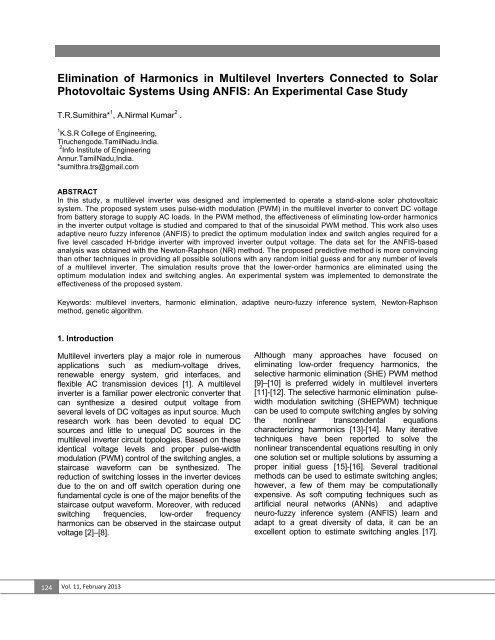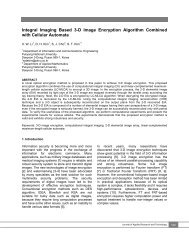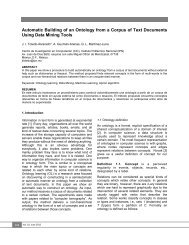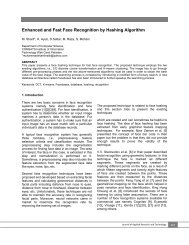Elimination of Harmonics in Multilevel Inverters Connected to ... - JART
Elimination of Harmonics in Multilevel Inverters Connected to ... - JART
Elimination of Harmonics in Multilevel Inverters Connected to ... - JART
You also want an ePaper? Increase the reach of your titles
YUMPU automatically turns print PDFs into web optimized ePapers that Google loves.
<strong>Elim<strong>in</strong>ation</strong> <strong>of</strong> <strong>Harmonics</strong> <strong>in</strong> <strong>Multilevel</strong> <strong>Inverters</strong> <strong>Connected</strong> <strong>to</strong> Solar<br />
Pho<strong>to</strong>voltaic Systems Us<strong>in</strong>g ANFIS: An Experimental Case Study<br />
T.R.Sumithira* 1 , A.Nirmal Kumar 2 .<br />
1 K.S.R College <strong>of</strong> Eng<strong>in</strong>eer<strong>in</strong>g,<br />
Tiruchengode.TamilNadu.India.<br />
2 Info Institute <strong>of</strong> Eng<strong>in</strong>eer<strong>in</strong>g<br />
Annur.TamilNadu,India.<br />
*sumithra.trs@gmail.com<br />
ABSTRACT<br />
In this study, a multilevel <strong>in</strong>verter was designed and implemented <strong>to</strong> operate a stand-alone solar pho<strong>to</strong>voltaic<br />
system. The proposed system uses pulse-width modulation (PWM) <strong>in</strong> the multilevel <strong>in</strong>verter <strong>to</strong> convert DC voltage<br />
from battery s<strong>to</strong>rage <strong>to</strong> supply AC loads. In the PWM method, the effectiveness <strong>of</strong> elim<strong>in</strong>at<strong>in</strong>g low-order harmonics<br />
<strong>in</strong> the <strong>in</strong>verter output voltage is studied and compared <strong>to</strong> that <strong>of</strong> the s<strong>in</strong>usoidal PWM method. This work also uses<br />
adaptive neuro fuzzy <strong>in</strong>ference (ANFIS) <strong>to</strong> predict the optimum modulation <strong>in</strong>dex and switch angles required for a<br />
five level cascaded H-bridge <strong>in</strong>verter with improved <strong>in</strong>verter output voltage. The data set for the ANFIS-based<br />
analysis was obta<strong>in</strong>ed with the New<strong>to</strong>n-Raphson (NR) method. The proposed predictive method is more conv<strong>in</strong>c<strong>in</strong>g<br />
than other techniques <strong>in</strong> provid<strong>in</strong>g all possible solutions with any random <strong>in</strong>itial guess and for any number <strong>of</strong> levels<br />
<strong>of</strong> a multilevel <strong>in</strong>verter. The simulation results prove that the lower-order harmonics are elim<strong>in</strong>ated us<strong>in</strong>g the<br />
optimum modulation <strong>in</strong>dex and switch<strong>in</strong>g angles. An experimental system was implemented <strong>to</strong> demonstrate the<br />
effectiveness <strong>of</strong> the proposed system.<br />
Keywords: multilevel <strong>in</strong>verters, harmonic elim<strong>in</strong>ation, adaptive neuro-fuzzy <strong>in</strong>ference system, New<strong>to</strong>n-Raphson<br />
method, genetic algorithm.<br />
1. Introduction<br />
<strong>Multilevel</strong> <strong>in</strong>verters play a major role <strong>in</strong> numerous<br />
applications such as medium-voltage drives,<br />
renewable energy system, grid <strong>in</strong>terfaces, and<br />
flexible AC transmission devices [1]. A multilevel<br />
<strong>in</strong>verter is a familiar power electronic converter that<br />
can synthesize a desired output voltage from<br />
several levels <strong>of</strong> DC voltages as <strong>in</strong>put source. Much<br />
research work has been devoted <strong>to</strong> equal DC<br />
sources and little <strong>to</strong> unequal DC sources <strong>in</strong> the<br />
multilevel <strong>in</strong>verter circuit <strong>to</strong>pologies. Based on these<br />
identical voltage levels and proper pulse-width<br />
modulation (PWM) control <strong>of</strong> the switch<strong>in</strong>g angles, a<br />
staircase waveform can be synthesized. The<br />
reduction <strong>of</strong> switch<strong>in</strong>g losses <strong>in</strong> the <strong>in</strong>verter devices<br />
due <strong>to</strong> the on and <strong>of</strong>f switch operation dur<strong>in</strong>g one<br />
fundamental cycle is one <strong>of</strong> the major benefits <strong>of</strong> the<br />
staircase output waveform. Moreover, with reduced<br />
switch<strong>in</strong>g frequencies, low-order frequency<br />
harmonics can be observed <strong>in</strong> the staircase output<br />
voltage [2]–[8].<br />
Although many approaches have focused on<br />
elim<strong>in</strong>at<strong>in</strong>g low-order frequency harmonics, the<br />
selective harmonic elim<strong>in</strong>ation (SHE) PWM method<br />
[9]–[10] is preferred widely <strong>in</strong> multilevel <strong>in</strong>verters<br />
[11]-[12]. The selective harmonic elim<strong>in</strong>ation pulsewidth<br />
modulation switch<strong>in</strong>g (SHEPWM) technique<br />
can be used <strong>to</strong> compute switch<strong>in</strong>g angles by solv<strong>in</strong>g<br />
the nonl<strong>in</strong>ear transcendental equations<br />
characteriz<strong>in</strong>g harmonics [13]-[14]. Many iterative<br />
techniques have been reported <strong>to</strong> solve the<br />
nonl<strong>in</strong>ear transcendental equations result<strong>in</strong>g <strong>in</strong> only<br />
one solution set or multiple solutions by assum<strong>in</strong>g a<br />
proper <strong>in</strong>itial guess [15]-[16]. Several traditional<br />
methods can be used <strong>to</strong> estimate switch<strong>in</strong>g angles;<br />
however, a few <strong>of</strong> them may be computationally<br />
expensive. As s<strong>of</strong>t comput<strong>in</strong>g techniques such as<br />
artificial neural networks (ANNs) and adaptive<br />
neuro-fuzzy <strong>in</strong>ference system (ANFIS) learn and<br />
adapt <strong>to</strong> a great diversity <strong>of</strong> data, it can be an<br />
excellent option <strong>to</strong> estimate switch<strong>in</strong>g angles [17].<br />
124<br />
Vol. 11, February 2013
<strong>Elim<strong>in</strong>ation</strong> <strong>of</strong> <strong>Harmonics</strong> <strong>in</strong> <strong>Multilevel</strong> <strong>Inverters</strong> <strong>Connected</strong> <strong>to</strong> Solar Pho<strong>to</strong>voltaic Systems Us<strong>in</strong>g ANFIS: An Experimental Case Study, T.R.Sumithira / 124‐132<br />
Although microcontrollers are used for the solution<br />
<strong>of</strong> applications <strong>of</strong> <strong>in</strong>termediate complexity, recently<br />
FPGA processors are preferred widely <strong>in</strong> areas with<br />
high <strong>in</strong>tegration as well as compact and flexible<br />
extension <strong>of</strong> the system [18].<br />
However, <strong>to</strong> the authors knowledge, the adaptive<br />
neuro-fuzzy <strong>in</strong>ference system (ANFIS)-based<br />
prediction <strong>of</strong> switch<strong>in</strong>g angles <strong>in</strong> five-level <strong>in</strong>verter<br />
has not been addressed so far. The case study is<br />
performed <strong>to</strong> develop the stand-alone multilevel<br />
<strong>in</strong>verter system connected <strong>to</strong> solar panels. The<br />
DC-DC converter was used <strong>to</strong> regulate the DC<br />
voltages from solar panels, which varied because<br />
<strong>of</strong> changes <strong>in</strong> solar radiation. Previous results <strong>of</strong> a<br />
study <strong>in</strong> prediction <strong>of</strong> solar radiation and siz<strong>in</strong>g <strong>of</strong><br />
panels for various regions <strong>of</strong> Tamilnadu, India [19]-<br />
[20] have now been utilized for the application <strong>of</strong><br />
the stand-alone multilevel <strong>in</strong>verter system. An<br />
attempt has been made <strong>to</strong> tra<strong>in</strong> the ANFIS<br />
prediction model <strong>to</strong> explore the prediction <strong>of</strong><br />
switch<strong>in</strong>g angles that can produce the desired<br />
fundamental voltage by elim<strong>in</strong>at<strong>in</strong>g the third-order<br />
harmonics. Moreover, the experimental work has<br />
been carried out <strong>to</strong> validate the proposed method.<br />
The paper is organized as follows. The next<br />
section presents the structure <strong>of</strong> the multilevel<br />
<strong>in</strong>verter and the SHE-based modulation adopted <strong>to</strong><br />
elim<strong>in</strong>ate the higher-order harmonics. It also<br />
depicts the determ<strong>in</strong>ation method for switch<strong>in</strong>g<br />
angles that can be used <strong>to</strong> frame the data set for<br />
ANFIS tra<strong>in</strong><strong>in</strong>g. Section 3 describes the state-<strong>of</strong>-art<br />
ANFIS predicition method. Section 4 presents the<br />
experimental work and its results.<br />
Figure 1. Five-level cascaded H<br />
bridge multilevel <strong>in</strong>verter.<br />
The number <strong>of</strong> levels <strong>in</strong> the output phase voltage is<br />
manipulated by 2s+1, where s is the number <strong>of</strong> H-<br />
bridges units utilized. The system chosen <strong>in</strong> this<br />
study bears two full-bridge <strong>in</strong>verters, each<br />
connected <strong>to</strong> 4 solar panels <strong>of</strong> 85 W p capacity.<br />
Figure 2 shows the output voltage waveform <strong>of</strong><br />
the five-level cascaded H-bridge <strong>in</strong>verter. The<br />
magnitude <strong>of</strong> the AC output phase voltage is given<br />
by v pn =vah 1 + vah 2 where vah 1 and vah 2 are the<br />
voltages correspond<strong>in</strong>g <strong>to</strong> the switch<strong>in</strong>g angles, α 1<br />
and α 2 .<br />
2. <strong>Multilevel</strong> <strong>in</strong>verter<br />
In the family <strong>of</strong> multilevel <strong>in</strong>verters, the cascade<br />
multilevel <strong>in</strong>verter is one <strong>of</strong> the significant<br />
<strong>to</strong>pologies. It requires less components, a modular<br />
structure with a simple switch<strong>in</strong>g strategy, and an<br />
easily adjusted number <strong>of</strong> output voltage levels by<br />
add<strong>in</strong>g or remov<strong>in</strong>g full-bridge cells [21]-[22]. The<br />
cascade multilevel <strong>in</strong>verter is composed <strong>of</strong> a<br />
number <strong>of</strong> H-bridge <strong>in</strong>verter units with a separate<br />
DC source for each unit and can be connected <strong>in</strong><br />
cascade <strong>to</strong> produce a near s<strong>in</strong>usoidal output<br />
voltage waveform us<strong>in</strong>g the proper modulation<br />
scheme.as shown <strong>in</strong> Figure 1.<br />
Figure 2. Generalized stepped voltage waveform<br />
<strong>of</strong> the multilevel <strong>in</strong>verter.<br />
Although there are different switch<strong>in</strong>g strategies<br />
available for m<strong>in</strong>imization and elim<strong>in</strong>ation <strong>of</strong><br />
harmonics [23]-[24], <strong>in</strong> this work, the s<strong>in</strong>usoidal<br />
pulse-width modulation (SPWM) and selective<br />
harmonic elim<strong>in</strong>ation pulse-width modulation<br />
(SHEPWM) were developed <strong>to</strong> m<strong>in</strong>imize and<br />
elim<strong>in</strong>ate the low-order harmonics, respectively.<br />
Journal <strong>of</strong> Applied Research and Technology 125
<strong>Elim<strong>in</strong>ation</strong> <strong>of</strong> <strong>Harmonics</strong> <strong>in</strong> <strong>Multilevel</strong> <strong>Inverters</strong> <strong>Connected</strong> <strong>to</strong> Solar Pho<strong>to</strong>voltaic Systems Us<strong>in</strong>g ANFIS: An Experimental Case Study, T.R.Sumithira / 124‐132<br />
2.1 S<strong>in</strong>usoidal pulse-width modulation (SPWM)<br />
The SPWM technique is one <strong>of</strong> the primitive<br />
techniques; it is used <strong>to</strong> suppress harmonics present<br />
<strong>in</strong> the quasi-square wave. In SPWM, a carrier wave<br />
is compared with a reference wave [25]-[26]. The<br />
reference wave corresponds <strong>to</strong> the desired<br />
fundamental frequency at the output and the<br />
triangular wave determ<strong>in</strong>es the frequency with which<br />
values are switched. By chang<strong>in</strong>g the frequency <strong>of</strong><br />
the carrier wave, higher switch<strong>in</strong>g frequencies can be<br />
obta<strong>in</strong>ed. In order <strong>to</strong> avoid the elim<strong>in</strong>ation <strong>of</strong> the even<br />
harmonics, the carrier frequency should always be an<br />
odd multiple <strong>of</strong> three.<br />
2.2 Selective harmonic elim<strong>in</strong>ation pulse-width<br />
modulation (SHEPWM)<br />
Traditionally, the Fourier series expansion for any<br />
output <strong>of</strong> the system can be expressed as <strong>in</strong><br />
Equation (1):<br />
V (ωt) = ∑<br />
∞<br />
( cos ωt + s<strong>in</strong> ωt) (1)<br />
As it is an odd symmetric function, the value <strong>of</strong> a0 =<br />
a n = 0 (amplitude <strong>of</strong> the even harmonic component)<br />
and b n . The Fourier series expansion <strong>of</strong> the<br />
waveform with the same magnitude than all the DC<br />
sources can be expressed as <strong>in</strong> Equation (2):<br />
V (ωt) = <br />
∞<br />
<br />
V s<strong>in</strong>(nωt)<br />
(2)<br />
where, V n is the amplitude <strong>of</strong> the harmonics. The<br />
magnitude <strong>of</strong> Vn becomes zero for even-order<br />
harmonics because <strong>of</strong> an odd quarter-wave<br />
symmetric characteristic:<br />
V n = 0<br />
<br />
<br />
∑ <br />
cos ;<br />
(3)<br />
Where is the switch<strong>in</strong>g angle limited between<br />
and V dc is the voltage <strong>of</strong> DC sources which are <strong>of</strong><br />
the same magnitude. Subsequently, V n becomes<br />
∞<br />
4<br />
V (ωt) = <br />
(cos( )<br />
,,<br />
+…cos ) s<strong>in</strong>(mωt)<br />
(4)<br />
Where j is the number <strong>of</strong> switch<strong>in</strong>g angles and m is<br />
the harmonic order.<br />
Ideally, <strong>in</strong> the multilevel <strong>in</strong>verters, there can be k<br />
number <strong>of</strong> switch<strong>in</strong>g angles, <strong>in</strong> which one switch<strong>in</strong>g<br />
angle can be used for fundamental voltage<br />
selection and the rema<strong>in</strong><strong>in</strong>g (k-1) switch<strong>in</strong>g angles<br />
can be used <strong>to</strong> elim<strong>in</strong>ate few prime low-order<br />
harmonics. Moreover, the modulation <strong>in</strong>dex is<br />
def<strong>in</strong>ed as the ratio fundamental output voltage V 1<br />
<strong>to</strong> the maximum obta<strong>in</strong>able voltage V max as<br />
shown <strong>in</strong> Equation (5):<br />
= <br />
<br />
<br />
<br />
; = * V dc (5)<br />
The range <strong>of</strong> is considered as the fundamental<br />
l<strong>in</strong>ear modulation component. For the five-level<br />
cascade <strong>in</strong>verter ,k value is 2 or two degrees <strong>of</strong><br />
freedom are available; one degree <strong>of</strong> freedom can<br />
be used <strong>to</strong> control the magnitude <strong>of</strong> the<br />
fundamental voltage and the other can be used <strong>to</strong><br />
elim<strong>in</strong>ate the third-order harmonic component as<br />
it contributes more <strong>to</strong> the <strong>to</strong>tal harmonic<br />
dis<strong>to</strong>rtion. The follow<strong>in</strong>g equations (6)–(7) can be<br />
obta<strong>in</strong>ed from the above-stated conditions <strong>to</strong><br />
manipulate the switch<strong>in</strong>g angle for perform<strong>in</strong>g<br />
selective harmonic elim<strong>in</strong>ation:<br />
[cos ∝ + cos ∝ ] = 2 * m i (6)<br />
[cos 3 ∝ + cos 3 ∝ ] = 0 (7)<br />
2.2.1 New<strong>to</strong>n-Raphson Method<br />
These nonl<strong>in</strong>ear polynomial equations can be<br />
solved by the iterative New<strong>to</strong>n-Raphson method <strong>to</strong><br />
determ<strong>in</strong>e the switch<strong>in</strong>g angles, α 1 and α 2 . The<br />
<strong>in</strong>itial guess for switch<strong>in</strong>g angles (α 1 , α 2 ) lies <strong>in</strong><br />
between 0 and π/2. The flow chart for the New<strong>to</strong>n-<br />
Raphson method can be used <strong>to</strong> compute all<br />
possible solutions without any computational<br />
complexity as shown <strong>in</strong> Figure 3.<br />
The NR method approach is capable <strong>of</strong> f<strong>in</strong>d<strong>in</strong>g<br />
analytical solutions for limited ranges. It gives a<br />
more approximate solution <strong>in</strong> provid<strong>in</strong>g a smooth<br />
data set that is needed for the ANFIS tra<strong>in</strong><strong>in</strong>g.<br />
126<br />
Vol. 11, February 2013
<strong>Elim<strong>in</strong>ation</strong> <strong>of</strong> <strong>Harmonics</strong> <strong>in</strong> <strong>Multilevel</strong> <strong>Inverters</strong> <strong>Connected</strong> <strong>to</strong> Solar Pho<strong>to</strong>voltaic Systems Us<strong>in</strong>g ANFIS: An Experimental Case Study, T.R.Sumithira / 124‐132<br />
Rule i:<br />
Figure 4. ANFIS architecture.<br />
; h = + +<br />
; = 1; 2 (8)<br />
Figure 3. Flow chart for the New<strong>to</strong>n-Raphson method.<br />
3. Adaptive neuro-fuzzy <strong>in</strong>ference system<br />
3.1 State-<strong>of</strong>-The-Art : ANFIS theory<br />
ANFIS is a hybrid s<strong>of</strong>t comput<strong>in</strong>g model composed<br />
<strong>of</strong> a neuro-fuzzy system <strong>in</strong> which a fuzzy <strong>in</strong>ference<br />
(high-level reason<strong>in</strong>g capability) system can be<br />
tra<strong>in</strong>ed by a neural network-learn<strong>in</strong>g (low-level<br />
computational power) algorithm. ANFIS has the<br />
neural network’s ability <strong>to</strong> classify data <strong>in</strong> groups<br />
and f<strong>in</strong>d patterns and further develop a transparent<br />
fuzzy expert system. Moreover, ANFIS has the<br />
ability <strong>to</strong> divide and adapt these groups <strong>to</strong> arrange<br />
a best membership function that can cluster and<br />
deduce the desired output with<strong>in</strong> a m<strong>in</strong>imum<br />
number <strong>of</strong> epochs [27]-[28]. The fuzzy <strong>in</strong>ference<br />
system can be tuned by the learn<strong>in</strong>g mechanism.<br />
A given <strong>in</strong>put/output data set, ANFIS constructs a<br />
fuzzy <strong>in</strong>ference system (FIS) whose membership<br />
function parameters can be tuned (adjusted) us<strong>in</strong>g<br />
either a back-propagation algorithm alone or <strong>in</strong><br />
comb<strong>in</strong>ation with a least squares type <strong>of</strong> method.<br />
Figure 4 shows the ANFIS architecture used <strong>in</strong> this<br />
work. This system has two <strong>in</strong>puts x and y and one<br />
output, whose rule is.<br />
where f i is the output and p i , q i and r i are the<br />
consequent parameters <strong>of</strong> ith rule. A i and B i are the<br />
l<strong>in</strong>guistic labels represented by fuzzy sets. The<br />
output <strong>of</strong> each node <strong>in</strong> every layer can be denoted<br />
by where i specifies the neuron number <strong>of</strong> the<br />
next layer and l is the layer number [29]-[30] . In the<br />
first layer, called fuzzify<strong>in</strong>g layer, the l<strong>in</strong>guistic<br />
labels are Ai and Bi. The output <strong>of</strong> the layer is the<br />
membership function <strong>of</strong> these l<strong>in</strong>guistic labels and<br />
is expressed as.<br />
<br />
<br />
= ()<br />
<br />
<br />
= ()<br />
where () and () are membership<br />
functions that determ<strong>in</strong>e the degree <strong>to</strong> which the<br />
given x and y satisfy the quantifiers Ai and Bi. In the<br />
second layer, the fir<strong>in</strong>g strength for each rule<br />
quantify<strong>in</strong>g the extent <strong>to</strong> which any <strong>in</strong>put data<br />
belongs <strong>to</strong> that rule is calculated [31]. The output <strong>of</strong><br />
the layer is the algebraic product <strong>of</strong> the <strong>in</strong>put<br />
signals as can be given as<br />
= () ∩ () ; i = 1,2 (9)<br />
Journal <strong>of</strong> Applied Research and Technology 127
<strong>Elim<strong>in</strong>ation</strong> <strong>of</strong> <strong>Harmonics</strong> <strong>in</strong> <strong>Multilevel</strong> <strong>Inverters</strong> <strong>Connected</strong> <strong>to</strong> Solar Pho<strong>to</strong>voltaic Systems Us<strong>in</strong>g ANFIS: An Experimental Case Study, T.R.Sumithira / 124‐132<br />
‘‘∩’’ denotes a fuzzy ∩ norm opera<strong>to</strong>r which is a<br />
function that describes a superset <strong>of</strong> fuzzy<br />
<strong>in</strong>tersection (AND) opera<strong>to</strong>rs, <strong>in</strong>clud<strong>in</strong>g m<strong>in</strong>imum or<br />
algebraic product. In this study, an algebraic<br />
product was used. In the third layer, called the<br />
normalization layer, every node calculates the ratio<br />
<strong>of</strong> the ith rule’s fir<strong>in</strong>g strength <strong>to</strong> the sum <strong>of</strong> all rules’<br />
fir<strong>in</strong>g strengths [32].<br />
=<br />
<br />
<br />
; i = 1,2 (10)<br />
In the fourth layer, the output <strong>of</strong> every node is<br />
-squares method and the back-propagation<br />
gradient descent method for tra<strong>in</strong><strong>in</strong>g (fuzzy<br />
<strong>in</strong>ference system) FIS membership functions (MFs)<br />
parameters <strong>to</strong> estimate a given tra<strong>in</strong><strong>in</strong>g data set.<br />
Three gbell-shaped membership function was<br />
assigned for tra<strong>in</strong><strong>in</strong>g FIS membership functions.<br />
The model was tra<strong>in</strong>ed with data set framed by<br />
analytical method and the genetic algorithm<br />
method. Figure 5 shows the proposed ANFIS<br />
prediction model. In this work, the <strong>in</strong>put variables<br />
are array voltages from the solar panel and the<br />
switch<strong>in</strong>g angles.<br />
= ( + + ) (11)<br />
= ∑<br />
<br />
<br />
∑<br />
<br />
(12)<br />
The ANFIS learn<strong>in</strong>g algorithm employs two<br />
methods for updat<strong>in</strong>g membership function<br />
parameters [34-35]:<br />
A hybrid method consist<strong>in</strong>g <strong>of</strong> backpropagation<br />
for the parameters associated<br />
with the <strong>in</strong>put membership functions, and least<br />
squares estimation for the parameters<br />
associated with the output membership<br />
functions.<br />
Back propagation for all parameters.<br />
In order <strong>to</strong> improve the tra<strong>in</strong><strong>in</strong>g efficiency, a hybrid<br />
learn<strong>in</strong>g algorithm can be applied <strong>to</strong> justify the<br />
parameters <strong>of</strong> the <strong>in</strong>put and output membership<br />
functions. The only user-specified <strong>in</strong>formation is the<br />
number <strong>of</strong> membership functions for each <strong>in</strong>put and<br />
the <strong>in</strong>put–output tra<strong>in</strong><strong>in</strong>g <strong>in</strong>formation. Hence, the<br />
output can be written as<br />
f= w ̅1 f 1 + w ̅2f 2 (13)<br />
3.2 Design <strong>of</strong> the Proposed ANFIS Model<br />
The design <strong>of</strong> the ANFIS model was developed by<br />
us<strong>in</strong>g MATLAB 7.5.0.3402 (R2007) s<strong>of</strong>tware<br />
version. In this study, the ANFIS model was used<br />
with a hybrid learn<strong>in</strong>g algorithm <strong>to</strong> identify<br />
parameters <strong>of</strong> Sugeno-type fuzzy <strong>in</strong>ference<br />
systems. It applies a comb<strong>in</strong>ation <strong>of</strong> the least<br />
Figure 5. ANFIS architecture.<br />
3.2 ANFIS simulation results.<br />
The tra<strong>in</strong>ed ANFIS network can be observed <strong>to</strong><br />
experience a negligible tra<strong>in</strong><strong>in</strong>g error <strong>of</strong> 0.00066062<br />
as shown <strong>in</strong> Figure 6. The switch<strong>in</strong>g angles α1 and<br />
α2 along with the modulation <strong>in</strong>dex <strong>in</strong> the range <strong>of</strong><br />
0.65 < mi< 1.1, which were obta<strong>in</strong>ed by the<br />
New<strong>to</strong>n-Raphson method for the five -level <strong>in</strong>verter<br />
with third harmonic elim<strong>in</strong>ation is shown <strong>in</strong> Figure<br />
7. The values <strong>of</strong> the switch<strong>in</strong>g angle and the<br />
modulation <strong>in</strong>dex were used for the tra<strong>in</strong><strong>in</strong>g and<br />
test<strong>in</strong>g phase. Figure 8 shows the comparative<br />
results <strong>of</strong> the study. From the results, it is clear that<br />
the optimum modulation <strong>in</strong>dex at which the<br />
switch<strong>in</strong>g angles provide a more appropriate<br />
solution <strong>of</strong> harmonic elim<strong>in</strong>ation can be obta<strong>in</strong>ed<br />
faster with negligible error. Table 1 shows a<br />
comparison between some <strong>of</strong> the other models<br />
found <strong>in</strong> the literature and the proposed model <strong>in</strong><br />
this work. The results obta<strong>in</strong>ed show that ANFIS is<br />
a viable technique <strong>to</strong> predict the modulation <strong>in</strong>dex<br />
and its switch<strong>in</strong>g angles at which the third<br />
harmonics is completely elim<strong>in</strong>ated with<strong>in</strong> less<br />
number <strong>of</strong> iterations.<br />
128<br />
Vol. 11, February 2013
<strong>Elim<strong>in</strong>ation</strong> <strong>of</strong> <strong>Harmonics</strong> <strong>in</strong> <strong>Multilevel</strong> <strong>Inverters</strong> <strong>Connected</strong> <strong>to</strong> Solar Pho<strong>to</strong>voltaic Systems Us<strong>in</strong>g ANFIS: An Experimental Case Study, T.R.Sumithira / 124‐132<br />
Ref Method Year<br />
Tianhao Tang et.al., Gauss-New<strong>to</strong>n method 2006<br />
Jason R. Wells et.al., Genetic algorithm 2007<br />
Damoun<br />
et.al.,<br />
Ahmadi<br />
A. K. Al-Othman<br />
et.al.,<br />
New<strong>to</strong>n-Raphson<br />
method.<br />
Fuzzy l<strong>in</strong>ear regression<br />
method<br />
2009<br />
2010<br />
Faete Filho et.al., Artificial neural network 2011<br />
This author Adaptive neuro-fuzzy 2012<br />
<strong>in</strong>ference system<br />
Figure 6. Error dur<strong>in</strong>g tra<strong>in</strong><strong>in</strong>g phase.<br />
Table 1. Comparison <strong>of</strong> the proposed method with other<br />
methods found <strong>in</strong> the literature.<br />
4. Experimental results.<br />
A labora<strong>to</strong>ry pro<strong>to</strong>type composed <strong>of</strong> two separate<br />
DC supplies and a s<strong>in</strong>gle phase cascaded five-level<br />
<strong>in</strong>verter has been built us<strong>in</strong>g an <strong>in</strong>sulated gate<br />
bipolar transis<strong>to</strong>r (IGBT) as switch<strong>in</strong>g device; it is<br />
shown <strong>in</strong> Figure 9:<br />
Figure 7. Switch<strong>in</strong>g angle (α 1,α2.) variation for different<br />
modulation <strong>in</strong>dexes (0.1
<strong>Elim<strong>in</strong>ation</strong> <strong>of</strong> <strong>Harmonics</strong> <strong>in</strong> <strong>Multilevel</strong> <strong>Inverters</strong> <strong>Connected</strong> <strong>to</strong> Solar Pho<strong>to</strong>voltaic Systems Us<strong>in</strong>g ANFIS: An Experimental Case Study, T.R.Sumithira / 124‐132<br />
switches. A PIC microcontroller was used for fir<strong>in</strong>g<br />
pulse generation by the s<strong>in</strong>usoidal PWM and<br />
SHEPWM method. TOSHIBA 6N137 op<strong>to</strong>couplers<br />
were used <strong>to</strong> afford an isolation between the<br />
board and the power circuit. The ANFIS predicted<br />
modulation <strong>in</strong>dex and switch<strong>in</strong>g angles with third<br />
harmonic elim<strong>in</strong>ation <strong>in</strong> the five-level <strong>in</strong>verter were<br />
used experimentally. The simulated and<br />
experimental results <strong>of</strong> the output voltage <strong>in</strong> the<br />
five-level <strong>in</strong>verter can be observed as shown <strong>in</strong><br />
Figure 10. In Figure 11, the results <strong>of</strong> the FFT<br />
harmonic analysis carried performed by the SPWM<br />
and SHEPWM method are presented.<br />
(a)<br />
150<br />
100<br />
50<br />
Voltage(volts)<br />
0<br />
Voltage ( volts)<br />
-50<br />
-100<br />
-150<br />
0 2000 4000 6000 8000 10000 12000<br />
Time(sec)<br />
150<br />
100<br />
50<br />
0<br />
-50<br />
-100<br />
(a)<br />
-150<br />
0 2000 4000 6000 8000 10000 12000<br />
Time(sec)<br />
(b)<br />
(b)<br />
Figure 11. Harmonic Spectrum <strong>of</strong> (a) SPWM<br />
and (b) SHEPWM<br />
5. Conclusions<br />
The selective third harmonic elim<strong>in</strong>ation PWM<br />
method <strong>in</strong> a cascaded H-bridge five-level <strong>in</strong>verter<br />
was observed <strong>to</strong> provide significant change <strong>in</strong> the<br />
percentage <strong>of</strong> THD compared <strong>to</strong> the s<strong>in</strong>usoidal<br />
PWM method. The use <strong>of</strong> the ANFIS method <strong>to</strong><br />
estimate the modulation <strong>in</strong>dex and switch<strong>in</strong>g angles<br />
has been an additional advantage <strong>in</strong> claim<strong>in</strong>g that<br />
the system provides better elim<strong>in</strong>ation <strong>of</strong> harmful<br />
third harmonics at the <strong>in</strong>verter output voltage. The<br />
feasibility <strong>of</strong> this technique is addressed and the<br />
results through the harmonic spectrum are<br />
compared, show<strong>in</strong>g a significant difference. Results<br />
prove that the proposed method produces a fast<br />
and accurate response as well as m<strong>in</strong>imum error<br />
compared <strong>to</strong> the NR method. Simulation and<br />
experimental results show that the proposed<br />
design <strong>of</strong> a cascaded H-bridge five-level <strong>in</strong>verter is<br />
a viable option for any stand-alone solar<br />
pho<strong>to</strong>voltaic system with better output voltage.<br />
(c)<br />
Figure 10. Output voltage results <strong>of</strong> the case study. (a)<br />
Simulation results <strong>of</strong> the SPWM method. (b) Simulation<br />
results <strong>of</strong> the SHEPWM method. (c) Experimental results<br />
130<br />
Vol. 11, February 2013
<strong>Elim<strong>in</strong>ation</strong> <strong>of</strong> <strong>Harmonics</strong> <strong>in</strong> <strong>Multilevel</strong> <strong>Inverters</strong> <strong>Connected</strong> <strong>to</strong> Solar Pho<strong>to</strong>voltaic Systems Us<strong>in</strong>g ANFIS: An Experimental Case Study, T.R.Sumithira / 124‐132<br />
References<br />
[1] S. Alepuz, et.al. “Interfac<strong>in</strong>g renewable energy<br />
sources <strong>to</strong> the utility grid us<strong>in</strong>g a three-level <strong>in</strong>verter,”<br />
IEEE Trans. on Ind. Electron, vol. 53,no. 5, pp. 1504–<br />
1511, 2006.<br />
[2] V. G. Agelidis, A. Balouktsis, and M. S. A. Dahidah,<br />
“A five-level symmetrically def<strong>in</strong>ed selective harmonic<br />
elim<strong>in</strong>ation PWM strategy:<br />
Analysis and experimental validation,” IEEE Trans.<br />
Power Electron., vol. 23, no. 1, pp. 19–26, 2008.<br />
[3] A.K. AI-Othman and Tamer H. Abdel hamid.,<br />
“<strong>Elim<strong>in</strong>ation</strong> <strong>of</strong> <strong>Harmonics</strong> <strong>in</strong> <strong>Multilevel</strong> <strong>Inverters</strong> with<br />
Non-Equal DC Sources Us<strong>in</strong>g PSO.,” Elsevier Energy<br />
Conversion and Management, 2009.<br />
[4] J. N. Chiasson et.al. “Control <strong>of</strong> a multilevel converter<br />
us<strong>in</strong>g resultant theory,” IEEE Trans. Control Syst.<br />
Technol., vol. 11, no. 3, pp. 345–354, 2003.<br />
[5] J. N. Chiasson et.al. “A unified approach <strong>to</strong> solv<strong>in</strong>g<br />
the harmonic elim<strong>in</strong>ation equations <strong>in</strong> multilevel<br />
converters,” IEEE Trans. Power Electron., vol. 19, no. 2,<br />
pp. 478–490, 2004.<br />
[6] J. N. Chiasson et.al., “<strong>Elim<strong>in</strong>ation</strong> <strong>of</strong> harmonics <strong>in</strong> a<br />
multilevel converter us<strong>in</strong>g the theory <strong>of</strong> symmetric<br />
polynomials and resultants,” IEEE Trans. Control Syst.<br />
Technol., vol. 13, no 2, pp. 216–223, 2005.<br />
[7] J. N. Chiasson et.al. “The use <strong>of</strong> power sums <strong>to</strong> solve<br />
the harmonic elim<strong>in</strong>ation equations for multilevel<br />
converters,” Eur. Power Elect. Drives, vol. 15, no. 1, pp.<br />
19–27, 2005.<br />
[8] P.N. Enjeti, “Programmed PWM Techniques <strong>to</strong><br />
Elim<strong>in</strong>ate <strong>Harmonics</strong>: A Critical Evaluation,” IEEE Trans.<br />
Industry Applications, vol. 26, no. 2, pp. 302-316, 1990.<br />
[9] M.S. Dahidah and V. G. Agelidis, “Selective<br />
harmonics elim<strong>in</strong>ation PWM control for cascaded<br />
multilevel voltage source converters: A generalized<br />
formula,” IEEE Trans. Power Electron., vol. 23, no. 4,<br />
pp. 1620–1630, 2008.<br />
[10] J. Kumar, B. Das and A. Pramod, “Selective<br />
Harmonic <strong>Elim<strong>in</strong>ation</strong> Technique for a <strong>Multilevel</strong> Inverter,”<br />
Proceed<strong>in</strong>gs <strong>of</strong> Fifteenth National Power Systems<br />
Conference (NPSC), Bombay, 2008, pp 608-613.<br />
[11] Fang Zheng Peng et al, “A <strong>Multilevel</strong> Voltage-<br />
Source Inverter with Separate DC Sources for Static Var<br />
Generation,” IEEE Trans. on Ind Applications, vol. 32,<br />
no. 5, pp. 1130-1138, 1996.<br />
[12] L.M.Tolbert et.al, “<strong>Multilevel</strong> converters for large<br />
electric drives,” IEEE Trans. on Ind Applications, vol. 35,<br />
no. 1, pp. 36-44,1999.<br />
[13] Iwaszkiewicz Jan and Perz Jacek, “Fourier Series<br />
and Wavelet Transform Applied <strong>to</strong> Stepped Waveforms<br />
Synthesis <strong>in</strong> <strong>Multilevel</strong> Conver<strong>to</strong>rs,” Proceed<strong>in</strong>gs <strong>of</strong><br />
Electro technical Institute, 2006, pp. 59-74..<br />
[14] J.Wang , Y. Huang, and F. Z. Peng, “A practical<br />
harmonics elim<strong>in</strong>ation method for multilevel <strong>in</strong>verters,”<br />
Conf. Rec. IEEE IAS Annu. Meet<strong>in</strong>g, 2005, pp. 1665–1670.<br />
[15] J. Vassallo, J. C. Clare, and P. W. Wheeler, “Powerequalized<br />
harmonic-elim<strong>in</strong>ation scheme for utilityconnected<br />
cascaded H-bridge multilevel converters,”<br />
Proc. 29th IEEE IECON, 2003, pp. 1185–1190.<br />
[16] M. Mal<strong>in</strong>owski et.al, “A survey on cascaded<br />
multilevel <strong>in</strong>verters,“ IEEE Trans. Ind. Electron., vol. 57,<br />
no. 7, pp. 2197-2206, 2009.<br />
[17] S. Ledesma‐Orozco et.al., “Hurst Parameter<br />
Estimation Us<strong>in</strong>g Artificial Neural Networks,” J. <strong>of</strong> Appl.<br />
Res and Tech, vol. 9, no. 2, pp. 227-241, 2011.<br />
[18] C. Hernandez-Rosales et.al, “A standard<br />
microcontroller based discrete-time pi for controll<strong>in</strong>g the<br />
motion <strong>of</strong> a dc-gear mo<strong>to</strong>r, “ J. <strong>of</strong> App Res and Tech, vol.<br />
1 no. 1, pp. 44-52, 2005.<br />
[19] T.R.Sumithira, A.Nirmal Kumar, and R.<br />
Rameshkumar, “An adaptive neuro-fuzzy <strong>in</strong>ference<br />
system (ANFIS) based Prediction <strong>of</strong> Solar Radiation,” J.<br />
<strong>of</strong> App. Sci. Res, vol 8, no 1,pp 346-351,2012.<br />
[20] T.R.Sumithira, and A. Nirmal Kumar, “Prediction <strong>of</strong><br />
monthly global solar radiation us<strong>in</strong>g adaptive neuro fuzzy<br />
<strong>in</strong>ference system (ANFIS) technique over the stste <strong>of</strong><br />
Tamilnadu(India): a comparative study,” App. Sol<br />
.Energy(Spr<strong>in</strong>ger), vol 48,No 2,pp 140-145, 2012.<br />
[21] Jose Rodriguez, J.S. Lai, and F. Z. Peng,” <strong>Multilevel</strong><br />
<strong>Inverters</strong>: A Survey <strong>of</strong> Topologies, Controls, and<br />
Applications,” IEEE Trans. on Industrial Electronics, vol.<br />
49, no. 4, pp. 724-738,2002.<br />
[22] S. Kouro et.al, “Recent advances and <strong>in</strong>dustrial<br />
applications <strong>of</strong> multilevel converters, “ IEEE Trans. on<br />
Ind. Electron., vol. 57, no. 8, pp. 2553-2580,2008.<br />
[23] F.Z. Peng, J. W. McKeever, and D. J. Adams,<br />
“Cascade <strong>Multilevel</strong> <strong>Inverters</strong> for Utility Applications”,<br />
IECON Proceed<strong>in</strong>gs (Industrial Electronics Conference),<br />
1997,pp. 437-442.<br />
Journal <strong>of</strong> Applied Research and Technology 131
<strong>Elim<strong>in</strong>ation</strong> <strong>of</strong> <strong>Harmonics</strong> <strong>in</strong> <strong>Multilevel</strong> <strong>Inverters</strong> <strong>Connected</strong> <strong>to</strong> Solar Pho<strong>to</strong>voltaic Systems Us<strong>in</strong>g ANFIS: An Experimental Case Study, T.R.Sumithira / 124‐132<br />
[24] L.M.Tolbert, F. Z. Peng, and T. G. Habetler, “<strong>Multilevel</strong><br />
PWM methods at low modulation <strong>in</strong>dices,” IEEE Trans.<br />
Power Electron., vol. 15, no. 4, pp. 719–725, 2000.<br />
[25] N. Mohan. T.R. Undeland, W.P. Robb<strong>in</strong>s. Power<br />
Electronics. Converters, applications and design. John<br />
Wiley & Sons. 2003.<br />
[26] G. Carrara, S. Gardella, M. Marchesoni, R. Salutari,<br />
G. Sciut<strong>to</strong>, “A New <strong>Multilevel</strong> PWM Method: A<br />
Theoretical Analysis,” <strong>in</strong> Proc. IEEE Power Electron.<br />
Specialist Conf. (PESC), 1990, pp.363-371.<br />
[27] B. Ozp<strong>in</strong>eci, L. M. Tolbert, J. N. Chiasson,<br />
“Harmonic optimization <strong>of</strong> multilevel converters us<strong>in</strong>g<br />
Genetic Algorithms,” IEEE Power Electronics Letters,<br />
vol. 3, no. 3, pp. 92-95, 2005.<br />
[28] Übeyli, E. D et.al, “Adaptive neuro-fuzzy <strong>in</strong>ference<br />
system employ<strong>in</strong>g wavelet coefficients for detection <strong>of</strong><br />
ophthalmic arterial disorders,” Expert Systems with<br />
Applications, vol.34, no 3, 2008.<br />
[29] Y.M. Wang, M.S.Taha, and T.M. Elhag, “An<br />
adaptive neuro-fuzzy <strong>in</strong>ferencesystem for bridge risk<br />
assessment,” Expert Systems with Applications, vol.4<br />
no.3, pp 3099–3106,(2008).<br />
[30] E. Avci, and D. Avci, “The performance comparison<br />
<strong>of</strong> discrete wavelet neuralnetwork and discrete wavelet<br />
adaptive network based fuzzy <strong>in</strong>ference system for<br />
digital modulation recognition.” Expert Systems with<br />
Applications, vol.33, no 3. 2007.<br />
[31] E. Avci, D. Hanbay, and A. Varol, “An expert<br />
discrete wavelet adaptive network based fuzzy<br />
<strong>in</strong>ference system for digital modulation recognition.”<br />
Expert Systems with Applications, vol.33, no.3, pp<br />
582–589, 2007.<br />
[32] M.J.L Aznarte et.al, “Forecast<strong>in</strong>g airborne pollen<br />
concentration time series with neural and neuro-fuzzy<br />
models.” Expert Systems with Applications, vol.32.no.4,<br />
pp.1218–1225,2007.<br />
[33] M.Sorousha, and A.B.Parisa, “Intelligent scenario<br />
genera<strong>to</strong>r for bus<strong>in</strong>ess strategic plann<strong>in</strong>g by us<strong>in</strong>g<br />
ANFIS’” Expert Systems with Applications, vol 36,pp<br />
7729–7737,2009.<br />
[34] A. Ozturk, A. Arslan, and F. Hardalac, “Comparison<br />
<strong>of</strong> neuro-fuzzy systems for classification <strong>of</strong> transcranial<br />
doppler signals with their chaotic <strong>in</strong>variant measures,”<br />
Expert Systems with Applications, vol.34, no 2.,2008.<br />
[35] C. Elmas, O.Ustun, and H.Sayan, “A neuro-fuzzy<br />
controller for speedcontrol <strong>of</strong> a permanent magnet<br />
synchronous mo<strong>to</strong>r drive’” Expert Systems with<br />
Applications, vol.34, no.1.,2008.<br />
132<br />
Vol. 11, February 2013







